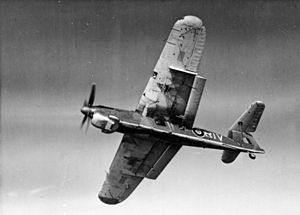Fairey Barracuda
| Barracuda | |
|---|---|
 |
|
| Fairey Barracuda Mk II | |
| Role | Torpedo bomber, dive bomber |
| National origin | United Kingdom |
| Manufacturer | Fairey Aviation |
| Built by |
Blackburn Aircraft Boulton Paul Westland Aircraft |
| First flight | 7 December 1940 |
| Introduction | 10 January 1943 |
| Primary user | Royal Navy |
| Produced | 1941–1945 |
| Number built | 2,607 |
The Fairey Barracuda was a British carrier-borne torpedo and dive bomber used during the Second World War, the first of its type used by the Royal Navy's Fleet Air Arm to be fabricated entirely from metal. It was introduced as a replacement for the Fairey Swordfish and Fairey Albacore biplanes. It is notable for its role in attacking the German battleship Tirpitz, and known for its ungainly appearance on the ground.
The Barracuda resulted from Air Ministry Specification S.24/37 issued in 1937 for a monoplane torpedo bomber to meet Operational Requirement OR.35. Of the six submissions, the designs of Fairey Aviation and Supermarine (Type 322) were selected and two prototypes of each ordered. The first Fairey prototype flew on 7 December 1940. The Supermarine Type 322 first flew in 1943 but with the Barracuda already in production it did not progress further.
The Barracuda was a shoulder-wing cantilever monoplane with an oval, all-metal fuselage. It had a retractable landing gear and non-retracting tailwheel. The hydraulically-operated main landing gear struts were of an "L" shape and retracted into a recess in the side of the fuselage, with the wheels held in the wing. A flush arrestor hook was fitted ahead of the tail wheel. The crew of three were in tandem under a continuous glazed canopy. The pilot had a sliding canopy and the other two crew members' canopy was hinged. The two rear-crew had alternate locations in the fuselage, with the navigator having bay windows below the wings for downward visibility. The wings had large Fairey-Youngman flaps that doubled as dive brakes. Originally fitted with a conventional tail, flight tests suggested stability would be improved by mounting the stabiliser higher, similar to a T-tail, which was implemented on the second prototype. For carrier stowage, the wings folded back horizontally at the roots; the peculiar small vertical protrusions on the upper wingtips held hooks that attached to the horizontal stabilizers.
...
Wikipedia
